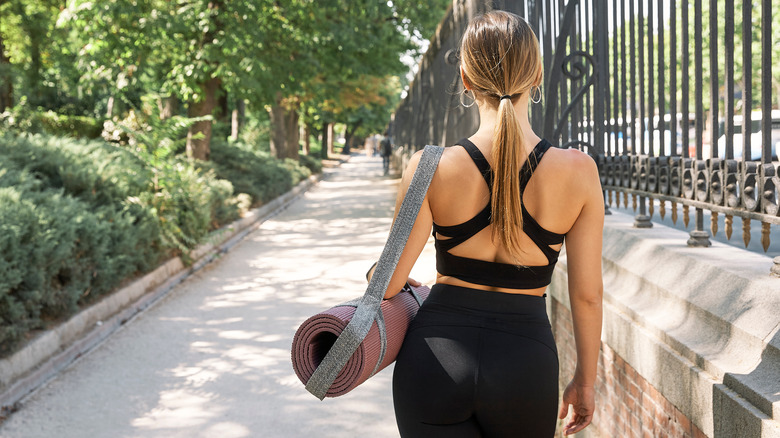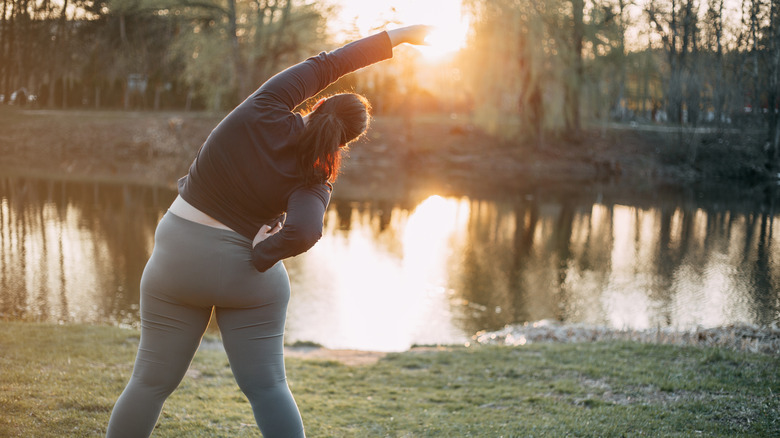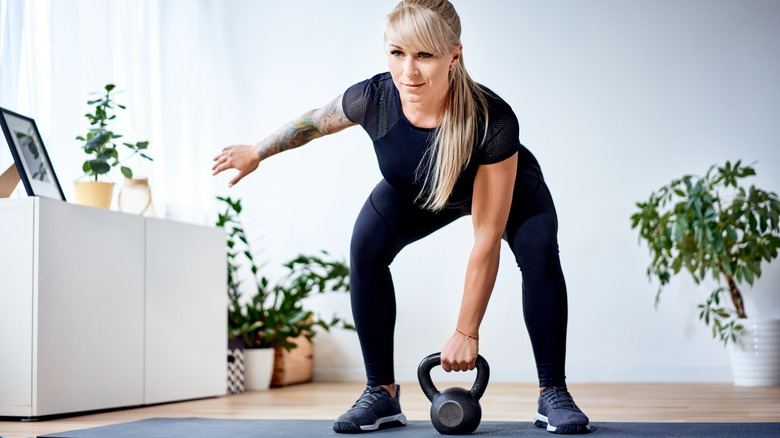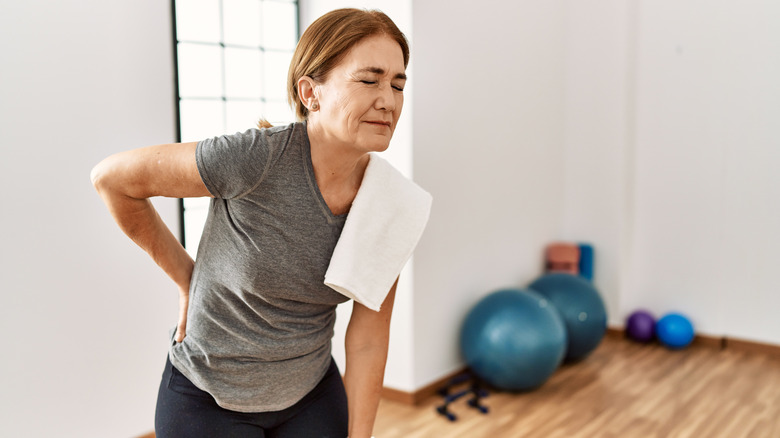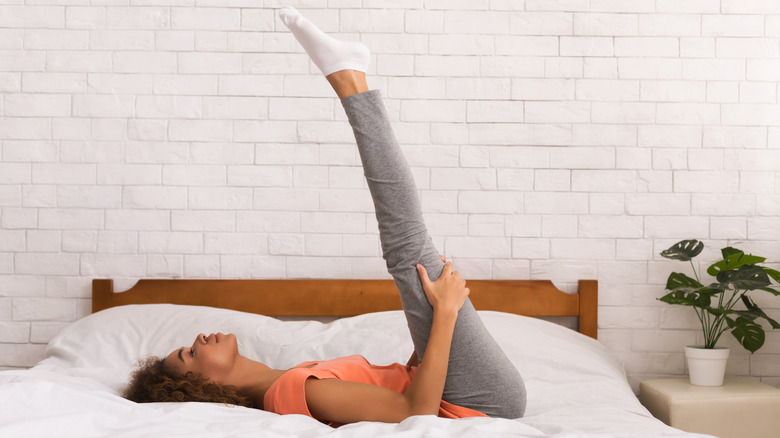What To Know About Working Out Your Posterior Chain
To understand the posterior chain, you must first understand how muscles work. In short, the brain sends chemical signals through the spinal cord and nervous system. When these chemicals reach a muscle fiber, they bind with receptors and the muscle contracts. When the signal stops flowing, the muscle releases as reported by Visible Body. We tend to think of our muscles as separate sections; you've got your quads, your deltoids, and your biceps, for example, but your muscles don't function independently of one another. If they did, you'd move more like a robot. Instead, they function together, relaxing, activating, and supporting each other in a series like a chain reaction, sometimes called a kinetic chain, per Healthline.
Your posterior chain involves all the muscle groups on the back of your body, from your toes to the crown of your head. The most significant muscles in the posterior chain include your calves, hamstrings, glutes, and back muscles. When you picture your body as a well-balanced hydraulic machine, rather than a collection of muscle groups, you can start to understand how these posterior muscles play a huge role in your overall movement, posture, and nervous system health. Here's what you need to know about keeping your posterior chain muscles strong and healthy.
What does the posterior chain do?
While we don't often think of them that way, the posterior muscles are some of the strongest and most important muscles in your body. Nearly every movement we make involves the posterior muscle groups manipulating or stabilizing the spine and skeletal system. The posterior chain bears the majority of the workload involved in everyday tasks, like standing up, sitting down, walking, twisting, and lifting. The erector spinae, muscles along your spine, help you twist and bend. Your calf muscles allow you to run, leap and dance. Even when you aren't moving, the gluteus maximus still has a very important job: keeping your torso upright. Because this ability to stand upright is so essential to humans, the gluteus maximus developed into the largest and one of the strongest muscles in the human body, per the Library of Congress.
When all these muscles work together, your body can do some pretty incredible things. If you've ever strained your back while lifting or pulled a hamstring while running, you know how one small posterior chain injury can put you out of commission for weeks. That's why strengthening your posterior chain is so crucial to preventing injuries, improving posture, and more.
Benefits of exercising your posterior chain
There are countless benefits to working out your posterior chain. For one, any regular exercise is great for the mind, body, and spirit. According to a study explored by Medical News Today, any form of exercise was shown to reduce the number of poor mental health days that study participants had, even performing household chores! Working out your posterior chain has tons of physical benefits too. For example, a strong back and glutes will give you better posture, which could also improve your gait and alleviate joint pain while walking.
Even if you're already in relatively good shape, you don't want to neglect your posterior chain at the gym. Focusing too much on exercising your abs, quads, and arms can lead to back and joint pain, but strengthening your posterior chain helps to balance out any over-training of the anterior muscles. Exercising your posterior chain can also improve your overall strength, helping your run faster and lift heavier during your workouts. Because these are some of the largest muscles in your body, they burn a lot of calories, and building them up can boost your metabolism. Finally, working out the posterior chain can help you establish a strong mind-body connection and physical awareness, otherwise known as proprioception per Healthline.
Exercises for your posterior chain
If all those benefits sound great to you, how should you get started? There are dozens of exercises that target specific muscles and muscle groups in the posterior chain. For most exercises, you don't even need special equipment or a gym membership. Just replace weights with gallon jugs and use your body weight as much as possible. Exercises like squats, calf raises, and pull-ups or pull-downs are perfect for targeting some of the most important muscles in your posterior chain. There are also some exercises that will help you activate and strengthen your entire posterior chain. Healthline recommends full-body exercises like Romanian deadlifts, kettlebell swings, supermans, or quadruplex. These challenging moves target the glutes, hamstrings, erector spinae, and upper back all in one motion.
Explosive exercises aren't the only way to build up your posterior chain. Isometric movements, like holding certain yoga poses, are great for improving posture and stability too. Before and after your workouts, make sure to show your posterior chain some love with hamstring stretches, forward folds, and downward dogs.
Risks associated with posterior chain workouts
As with any exercise, there are risks involved in working out your posterior chain. Because the posterior chain features some of the most important muscles for movement and posture, the risks are especially high. We assume our spines can take a lot of wear and tear, but you always need to be incredibly gentle with any exercise involving your back or spine. According to The Good Body, less than 15% of back injuries are caused by sudden trauma, and the vast majority (up to 92%) are caused by workplace injuries, poor posture, or bad lifting habits.
When you're working with your posterior chain, move slowly and use light weights until you can build up strength. Avoid over-exercising your posterior chain if you're recovering from a serious back injury or surgery or if you have a slipped disc, and never force yourself to complete a workout if you're in pain. The posterior chain is really important, but don't neglect your supporting muscles either! You should still be working out your core, in particular, to relieve some strain from your back.
Supportive habits for your posterior chain
Working out isn't the only thing you can do to support your posterior chain muscles. Establishing some healthy every day habits can help you feel your best and aid in muscle growth and retention. First, make sure you're practicing good posture in and out of the gym. Sit with your shoulders straight and your head upright, and avoid locking your knees while working out or standing, as this puts pressure on your lower back. Another good habit is to stretch every day, especially after you wake up, and take a break from sitting for a few minutes every hour.
As you're adding more posterior chain workouts to your routine, it's really important to stay hydrated. Livestrong explains that dehydration can lead to muscle cramps, especially in large muscles and the legs, so avoiding diuretics like caffeine and alcohol and drinking more water can give your posterior chain a big advantage. Finally, make sure you get enough rest and that you're sleeping with good spine alignment. The Mayo Clinic recommends supporting your spine by placing a pillow between your knees if you're a side sleeper, behind your knees if you're a back sleeper, or under your belly if you sleep on your stomach.
